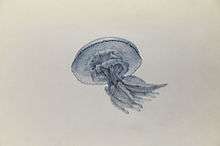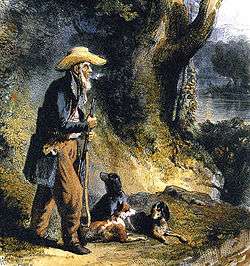Charles Alexandre Lesueur
| Charles Alexandre Lesueur | |
|---|---|
|
Lesueur in 1818, painted by Charles Willson Peale | |
| Born |
1 January 1778 Le Havre |
| Died |
12 December 1846 (aged 68) Le Havre |
| Nationality | French |
| Fields | Naturalist |




Charles Alexandre Lesueur (1 January 1778 in Le Havre – 12 December 1846 in Le Havre) was a French naturalist, artist and explorer.
In 1801 he travelled to Australia as artist on the expedition of Nicolas Baudin. With François Péron he took over the duties as naturalist after the death of the expedition's zoologist René Maugé. Together they collected over 100,000 zoological specimens. In 1802 he made the only known sketches of the King Island emu in its natural habitat (the bird became extinct in 1822).
Between 1815 and 1837 he lived in the United States. In 1833, he visited Vincennes, Indiana, where he sketched the first known drawing of Grouseland, the mansion of William Henry Harrison. The mansion is today a National Historic Landmark.
In the years 1825–1837 Lesueur lived in New Harmony, Indiana, where he filled sketchbooks full of the finds discovered during the utopian adventure funded by his friend William Maclure. He drew the boat "Philanthropist", which arrived full of intellectuals who came to live in the small town of New Harmony, on the Wabash River. He took research trips and sketched the people and the small towns in the area. He was in New Harmony when Prince Maximilian, Prince of Wied-Neuweid, Germany, and artist Karl Bodmer came to spend five months there in 1832–1833. Prince Maximilian said of Lesueur "He had explored the country in many directions, was acquainted with everything remarkable, collected and prepared all interesting objects and had already sent considerable collections to France" (Elliott & Johansen, p. 6) Indeed, Lesueur sent specimens of unique fish, animals and fossils, as well as artifacts he had dug from the Indian Mounds in New Harmony back to France, where they remain.
Lesueur returned to France in 1837, only after his friends Thomas Say and Joseph Barabino had died and William MacClure had returned to Philadelphia, accompanied by many of his fine books. He had spent 21 years in the United States, but continued his scholarly studies and activities in France, where he resumed his occupation of artist-naturalist and began to catalogue his extensive research and artwork. At last, he was awarded the honor of Chevalier de l’Ordre Royal de la Légion d'honneur for his long years of work in the sciences (Elliott & Johansen, p. 7).
In March 1846 Lesueur was appointed curator of the Musée d'Histoire Naturelle du Havre. Nine months later, he died suddenly (12 December 1846) and was buried at Le Havre. In the 1900s, his work was finally published by the Museum, totalling over 60 books, including reports of his zoological, geological, historical and archeological research, as well as studies of his life (Elliott & Johansen (Elliott & Johansen, p. 7).
Pictured here is the oil portrait by Charles Willson Peale of Charles-Alexandre Lesueur. The original hangs in the reading room of the Ewell Sale Stewart Library in the Academy of Natural Sciences of Philadelphia.
Eponyms
One species of frog and two species of lizards were named in honour of Lesueur:
- Litoria lesueurii (A.M.C. Duméril & Bibron, 1841) – Lesueur's frog (Hylidae)[1]
- Amalosia lesueurii (A.M.C. Duméril & Bibron, 1836) – Lesueur's velvet gecko (Diplodactylidae)[2]
- Intellagama lesueurii (Gray, 1831) – eastern water dragon (Agamidae)[2]
References
- ↑ Beolens B, Watkins M, Grayson M. 2013. The Eponym Dictionary of Amphibians. Exeter, England: Pelagic Publishing Ltd. xiii + 262 pp. ISBN 978-1-907807-41-1. ("Lesueur", p. 124).
- 1 2 Beolens B, Watkins M, Grayson M. 2011. The Eponym Dictionary of Reptiles. Baltimore: Johns Hopkins University Press. xiii + 296 pp. ISBN 978-1-4214-0135-5. ("Lesueur", p. 156).
Further reading
- Josephine Mirabella Elliott and Jane Thompson Johansen, Charles-Alexandre Lesueur: Premier Naturalist and Artist, New Harmony, Indiana, 1999.
- Claus Nissen: Die zoologische Buchillustration. Ihre Bibliographie und Geschichte. Vol. I: Bibliographie. Anton Hiersemann, Verlag 1969. Page 252.
- R. W. G. Vail, The American Sketchbooks of Charles Alexandre Lesueur, 1816–1837, American Antiquarian Society, 1938.
- Cédric Crémière et Gabrielle Baglione, Lesueur, Peintre voyageur, Un trésor oublié, coll. Très Grande Bibliothèque Thalassa, Éditions de Conti, Paris, 2009 (ISBN 9782351030110)
See also
External links
| Wikimedia Commons has media related to Charles Alexandre Lesueur. |
- Charles Alexandre Lesueur (1778–1846) naturalist, artist
- Muséum d'Histoire Naturelle, Le Havre (Lesueur, peintre voyageur) (French)
- Fishes Described and Drawn by C. A. Lesueur
- Graptemys geographica Lesueur (Map turtle, first described by Lesueur)
- Maclurites magnus Lesueur
- Alex the explorer, the hero of a new graphic novel
- Baudin's voyage – State Library (South Australia)
- Historic New Harmony (Indiana)
- L'expédition Baudin en Australie – Université de La Rochelle
- Charles A Lesueur Papers – Purdue University Libraries, Archives and Special Collections (Indiana, USA). Works of art on paper, including pencil, pastel, charcoal and watercolor sketches by artist and naturalist Charles Alexandre Lesueur, Virginia Dupalais, and Lucy Sistare [Say].
.png)